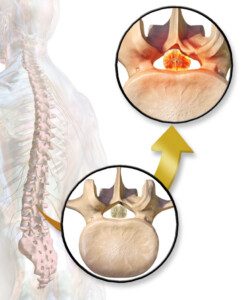Spinal stenosis is a spinal canal narrowing that can put pressure on the nerves in your spine.
There are multiple ways to prepare for spinal stenosis surgery.
Spinal stenosis can cause leg pain, back pain, and numbness or weakness in your legs, back and torso.
In some cases, doctors may recommend surgery to alleviate these symptoms.
If you are scheduled for spinal stenosis surgery, there are several things you can do to prepare.
Below is a guide to help you get ready for your surgery.
What is a spinal stenosis surgery?
This surgery is a decompression procedure to widen the space in your spine where the nerves travel.
This spine surgery helps relieve pressure on the spinal nerve roots, which can cause pain.

Spinal stenosis. BruceBlaus/CC BY-SA 4.0/creativecommons.org
Types of Surgery Options for Spinal Stenosis
Several types of surgery can be performed for spinal stenosis, depending on the severity of your symptoms, the location of your spinal stenosis, and your overall health.
Some surgeries for spinal stenosis include:
- Laminectomy: This surgery treats lumbar spinal stenosis, which removes part of the lamina, the back of the vertebra.
- Foraminotomy: This is a surgery to widen the opening in the vertebra where the nerve roots exit.
- Microdiscectomy: This is a surgery to remove a herniated disc.
- Ligament release: This minimally invasive surgery loosens the ligaments supporting the spine.
- Bone spur removal: This surgery removes bone spurs pressing on the nerves.
There is also a type of relief for spinal stenosis and surgery: spinal fusion.
For instance, lumbar spinal fusion can be used with other procedures to treat spinal stenosis in the lumbar spine.
However, it is important to realize that surgery is not always the best option for every individual.
Some people may be able to manage their symptoms with nonsurgical treatments such as physical therapy, pain medication and lifestyle changes.
Physical Preparation of Your Spine Surgery
The first step in preparing for spinal stenosis surgery is to get your body in good shape.

Depositphotos.com
This will help you to recover more quickly from surgery and reduce your risk of complications.
- Exercise regularly: Aim for moderate-intensity exercise for at least 30 minutes on most days of the week. Exercise will help strengthen your muscles and improve your flexibility, which will be important for your recovery.
- Lose weight, if necessary: Excess weight can strain your spine, so it’s important to lose weight if you are overweight or obese.
- Quit smoking: Smoking can damage your nerves and slow down your recovery. If you smoke, quitting now is the best thing you can do for your health.
- Have a healthful diet: A healthy diet will give you the nutrients you need to heal properly. Be sure to include a variety of fruits, vegetables and whole grains in your meals.
Emotional Preparation
In addition to physical preparation, preparing yourself emotionally for spinal stenosis surgery is also important.
This is a major surgery, and it is normal to feel anxious or scared.
- Talk to your doctor about your concerns: Your doctor can answer any questions about the surgery and help you feel more prepared.
- Talk to a therapist or counselor: If you are struggling to cope with the emotional stress of surgery, a therapist or counselor can help you to develop coping mechanisms.
- Join a support group: Talking to other people who have had the same surgery can be a great way to get support and advice.
The Day of Decompression Surgery
It’s important to arrive at the hospital early on the day of the surgery.
Upon arrival, check-in and change into a hospital gown will be required.
A meeting with the anesthesiologist to discuss the anesthesia plan will also occur.
In the operating room, the surgeon will administer an injection of local anesthesia into the area where the incision will be made.
This will numb the area and make the incision less painful.
The surgeon will then incise and remove the tissue compressing your nerves.
The length of your surgery will depend on the type of procedure that is performed.
Recovery
After surgery, you will wake up in the recovery room, where nurses will monitor you until you are stable.
You will likely experience some pain after surgery, but your doctor will prescribe medication to help you manage and relieve pain. Also, expect to wear a back brace for support.
You can expect to stay in the hospital for a few days after surgery, during which you’ll receive physical therapy to help regain strength and mobility.
Once you are discharged from the hospital, it’s important to continue with physical therapy at home and take it easy, avoiding strenuous activities for several weeks.
Prepare to Treat Spinal Stenosis
Spinal stenosis surgery is a major procedure but can relieve chronic pain and improve function.
By following these tips, you can ensure that you are in the best possible position to have a successful surgery and a smooth recovery.
Talk to your doctor if you have any questions or concerns about spinal stenosis surgery. They can help you make the best decision for your situation.


 Mohamed M. Abdulhamid, MD,
Mohamed M. Abdulhamid, MD,
























